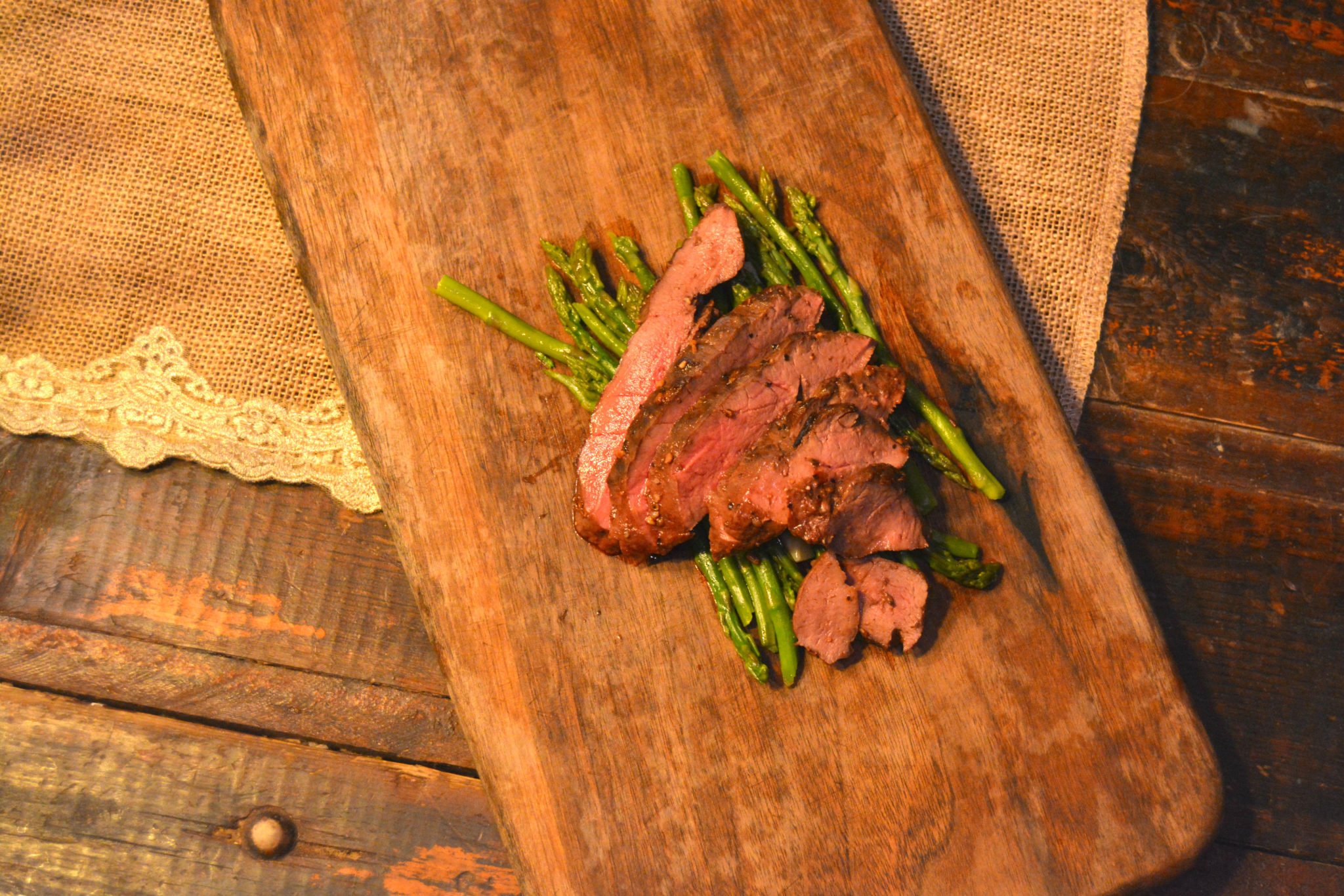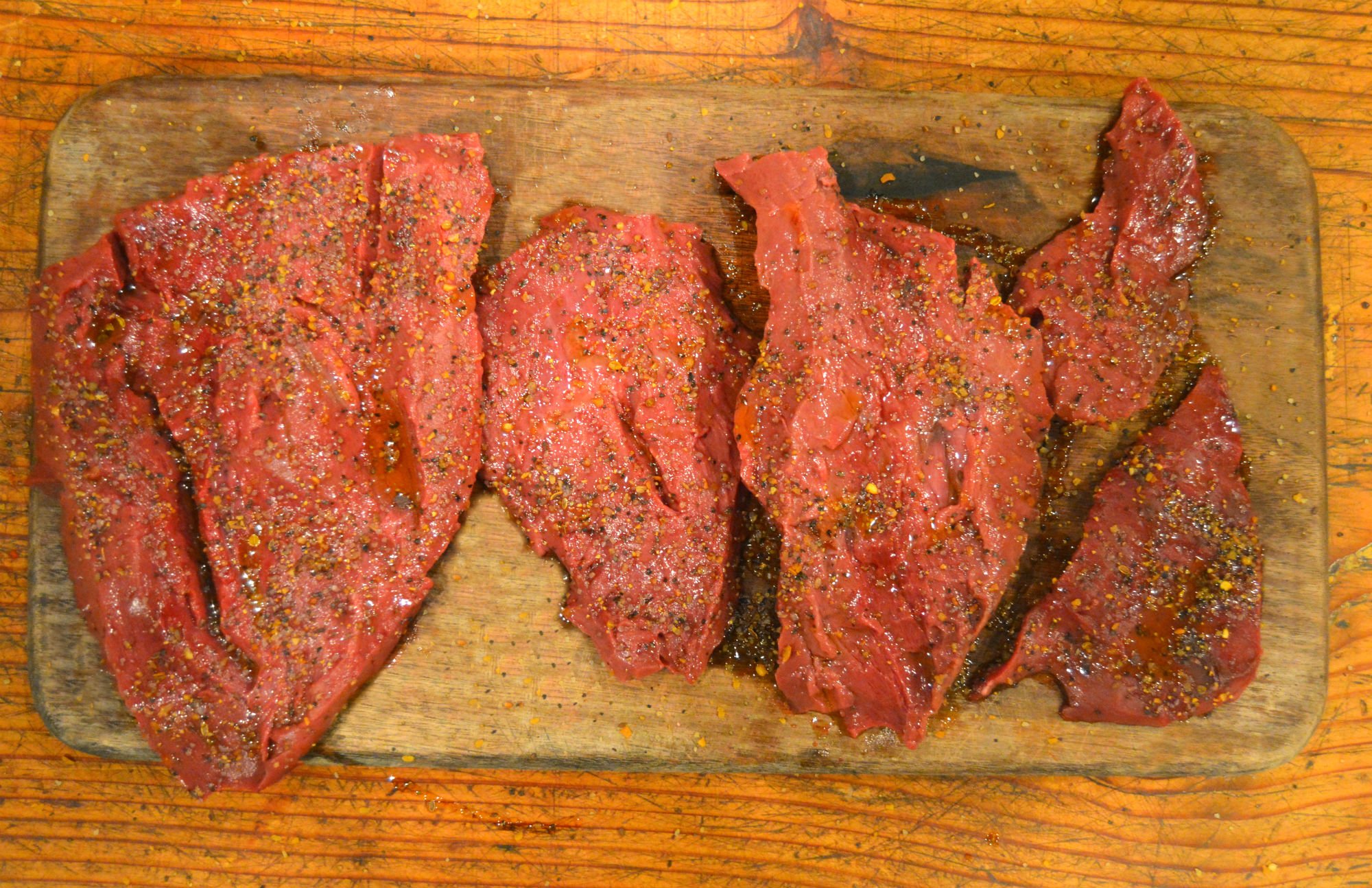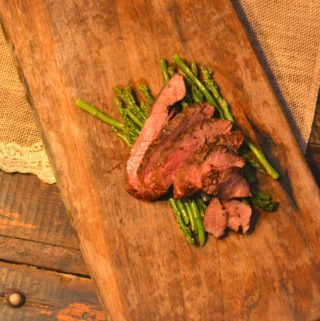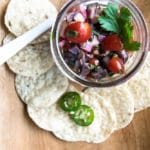
This post goes a bit in depth on elk heart ins-and-outs. For the recipe, scroll to the bottom, but know that there is a great recipe mixed in for cooking elk heart at hunting camp over open coals.
When I first tried elk heart and venison heart, I was not a fan; in fact, in our years to come afterwards, we would bring wild game heart home and package it, but I’d often give it to friends that loved the flavor of it. This of course, was during my first few years of learning to cook with wild game and not knowing how to get a good flavor out of the heart.
I grew up in the South and have plenty of recipes and pointers from Mom, Grandmas, Aunts, and Uncles on how to properly cook wild game – some of which are likely Southern traditions, more-so than actual trade secrets. I’ve also learned quite a few tips from my own research, but, better yet, Rocky Mountain hunters that have been hunting these regions for years. Between all of this knowledge, I’ve definitely learned a lot about the in’s-and-out’s of wild game, but of all of this much needed (and much appreciated) knowledge, not one person has ever mentioned recipes or pointers for offal like the heart or liver. Those tips and secrets I’ve had to find out through my own wins-and-fails and plenty of research.
The Secret to Good Elk Heart
After tasting bad elk heart recipes, I had to discover the reason why some people say it’s awful and why some people say it’s one of the best cuts of meat on the elk or venison. The secret is easy, take the time to clean the heart up the best you can. The more veins and white stuff you cut away, the better the meat will be; in fact, cutting it ALL away is what makes the heart literally taste like a filet mignon or part of the backstrap meat. When you see holes, cut that away until they’re gone, as well.
This is why so many hunters use this as the first celebratory meat, and the reason why so many hunters are more than happy to take your portion (because you don’t know how to cook it, right). If processed correctly, the heart can quickly be turned into one of your favorite cuts of the elk or venison (or moose, or antelope). Once processed correctly, elk heart can be cooked like any of your favorite elk steak recipes – steaks, fajitas, stews, or floured and pan fried. With just a few more recipe notes, you could easily get this cut of meat under-control and make it a table favorite.
Elk Heart Recipe Notes
I’ll start with regular elk heart recipe notes, but know that I got great notes and tips for hunting camp too, so make sure to read that part before scrolling to the recipe.
- A typical elk heart – cow or bull – can feed about 6 people (on average), but for our family of 4, one heart will feed all of us for dinner, with a bit left over to make heart steak salads for lunch the next day for Dad and Mom. A venison heart can feed 1-2 people. I’ve never had moose heart, but I’ve learned that it’s about the same size of an elk heart. The elk heart I cooked for the recipe below was 4 pounds before I started slicing away the fat and veins, and about 2.5 pounds after I finished processing it.
- You can marinate an elk heart anyway you’d like, but much like I mention with my Thin Venison Steak Recipe, a simple splash of olive oil, some balsamic, and a dash of salt and pepper is really all you need.
- Don’t worry about bringing the elk heart up to room temperature before cooking (also mentioned in the Thin Venison Steak Recipe), the cold helps give a good char on the outside, while keeping the inside nice and pink when you’re grilling – especially when doing it over an open fire at hunting camp.
- If butterflied or cut into heart steaks, I’ve learned to take the meat off about 5 degrees before I usually would the medium-rare temperature of 135°F. If I was to cook the elk heart whole, I’d definitely have to play more with these settings, but butterflied, take off between 125-130°F and let sit, tented with foil, for 10 minutes.
- Keep trimming away the white fat and veins. Make sure you look over the back, front, and in all of the cracks. Getting everything out of the little cracks when butterflied is a bit trickier to do than when cut into individual heart steaks – patients is a virtue.
- If you have the time, I highly recommend experimenting with different sauces. A1 was so 1980 (sorry A1, I so loved you before I discovered medium-rare meat). Try my morel mushroom white steak sauce, a gribiche sauce, or a balsamic reduction steak sauce. They’re all so much better with wild game steak and over a side of veggies.
Hunting Camp Food for Thought
I wanted to open with this section, because I think this is why I fell in love with hunting camp. There’s something about cooking over a open fire that has always excited my tastebuds and made me push my recipe skills, but doing so at hunting camp heightens that experience even more.
I already love cooking, researching, and exploring the world of cooking, and I think it’s because of my Southern background – which, of course, involves food for almost every event, mood, gathering, or just because. I grew up with never having to wonder if there’s enough food, and knowing that a ‘light lunch’ means there’s enough to feed half the block (or the farm and all of it’s ranch hands). Food is in my soul, and because of that, my love and passion for feeding my family the most amazing home cooked meals is what I live and breathe.
With all of that said, I love food more than just because I love to eat it – which is a big perk, – but because I get to make others happy, and at hunting camp, I can really shine with making people happy with food. After a full day hunt, coming back to a pot of stew of chili is any hunters dream, and if I can make that dream come true, I’m your girl. I love to go to hunting camp for the hunt, just as much as I do to cook for everyone when they return. Stews and chilis are perfect, because they can be made ahead of time, and just heated up over a hot fire – which saves your tired bones the energy of having to prep everything. But there’s something absolutely amazing, spectacularly special, primarily primal about taking fresh meat from a downed elk or deer of the day and cooking it for dinner the same night. Whether it be backstrap or elk heart, cooking over an open flame is easy when cooked directly on the hot coals or a piping hot grill grate.
Hunting Camp Elk Heart Recipe
After an elk is taken down and field dressed, the guts are usually removed, and the pile usually includes the heart and liver – both of which are edible. Because of the internal temperature of the elk, the heart will have a high body temperature that should be cooled down to have it at the right temperature for cooking over an open fire that night.
In the Rocky Mountains, we have cool temperatures, so we usually have plenty of time to pack it out back to camp and not have to worry about high temperatures ruining the heart. We typically bag it in a game bag and just stuff it in one of our hunting packs. By the time we get back to camp, I’ll do one of 3 things, depending on how hunting camp is setup.
- If we backpacked in and are next to a waterstream, I’ll rinse the heart in the stream (the water is usually so cold that my hands feel like they’re freezing), pump the heart a few times to try to flush out the blood, place the heart in a regular plastic grocery bag, and secure it to the edge so the water flows in the bag, but the bag doesn’t float away. The point is to get the temperature of the elk heart to cool down, while washing away the blood. I’m not usually worried about polluted water from high mountain streams (the only time I would be, is if I thought there may be a beaver dam upstream, which could cause bacterial issues, but since I’m cooking the heart – and not worried about drinking the water – this shouldn’t be a concern).
- If we backpacked in and are NOT next to a waterstream, I try to find a source of cold water on the way to camp to try to rinse the elk heart out – again, pumping a few times to try to get internal blood out. If you’re like me, you packed the Sea to Summit Kitchen Sink and you can scoop up some water to bring to camp; alternatively, you can always pack a plastic grocery sack or freezer bag. OR, if you’re super resourceful, you can pull the stomach lining out of the elk and use it to hold water for you back to camp – you’ll have to find a way to bind the stomach together to hold it up, hold the cold water, and hold the elk heart (you got this). You can also use water from your pack to soak the heart in, but that starts to get into murky situations, because you need to save enough water for yourself and likely need a water purifier (we like the Katadyn Hiking Water Filter) – which you should have anyway – to clean more water for yourself.
- If we went super-cush and decided to set-up hunting camp with RVs (so amazing sometimes), I’ll either rinse the heart and pump it a few times in a nearby stream or just soak it in cold water for about an hour from water from the camper; again, the point is to get the temperature down and as much blood out as possible.
After you’ve let the blood drain a bit (see carving tips below for cutting), keep things simple by sprinkling the butterflied elk heart with salt, pepper, olive oil, and perhaps a few aromatics. With a hot fire already going, push some of the hottest, reddest coals to the side where you can sit and cook your heart steak without burning your face – we do this by creating a sort of well to the side of the pit that makes it easy for cold hunters to still get the fire they need to warm up, but food can still easily be cooked and heated.
Now’s the fun part – this is my favorite – dirty steaks. That’s right, we’re making these heart steaks dirty. Over the red hot coals, place the butterflied elk heart directly on top of the coals. An ove-glove works great for turning the heart steaks and protecting your hands (the ove-glove was not marketed right; they needed me on their team so I could teach them about dirty steaks). Cook the butterflied elk heart about 5 minutes per side (depending on how hot your coals actually are, you may need a bit more time). If you didn’t butterfly your heart steaks, and instead cut them thinner, you’ll really need to babysit them to get the right cook/temperature. If you’re not sure if they’re done, use the thumb to finger method to test for doneness – or go find the right cook at camp that really knows how to cook steak and hand over your ove-glove.
Once done, pull off the elk heart, dust off any stuck on coals, and let rest for about 10 minutes. There will be grit, which is why they’re called dirty steaks; if it bothers you, wipe if off and put on your big girl panties to get prepared for this. Slice thin – or eat with your hands – either way, enjoy.
How Do You Cut Elk Heart?

There are sooooo many ways to cut elk heart; kidding, I’ve only seen, really, 3 different ways that people actually cut elk heart.
- Butterflied, which is great for cooking on hot coals at hunting camp.
- Cut into heart steaks after it’s been butterflied.
- Cut lengthwise; where the person would then cut the white part out of the holes within the middle of the heart steaks.
I’m sure any method is fine, but I find that butterflying them helps get the heart steaks cleaner. I’ve seen recipes where people crockpot their elk or venison hearts whole – with the fat left on sometimes – this is likely the recipes I tried before where I decided I definitely did not like heart. Just my opinion, of course, but I’d imagine that if you’re throwing a heart into a crockpot, butterflying the heart would be your best bet.
Okay, let’s get to actually cutting this elk heart.
- I’ve found that cutting an elk heart is a lot like cutting a bell pepper. You start with cutting the top half off, where all the valves and ventricles are. That cut is usually made right above the big, white fat line. Cutting straight down from there should do you fine and will expose 4 open chambers – this is what I’m referring to as looking like a bell pepper.
- To make a butterfly cut, you cut down one of those open chambers, much like you would if you wanted to lay a bell pepper flat. After that cut, cut around the 3 other chambers, which should lay the heart out semi-flat.
- At this point, you have a very good advantage to start trimming away as much silver skin, white fat, veins, and other ventricles you see. Make sure to flip it over and trim both sides as best you can. Obviously, a really good, really sharp fillet knife works best here. I use a rather unusual, small Victorinox fillet knife, with a sort of backward blade that works perfectly for me, but you may find something else works better for you. After working years in the restaurant industry, you quickly learn that a favorite knife of someone else may be the worst knife you’ve ever handled – find the knives YOU love. (Also, I’m left-handed, so I’ll just throw that in there when you’re asking what knife/knives I prefer).
- I’ve seen some Chefs cut the heart in half and start working from there. I suppose that could work just fine, but I’ve always found that butterflying the heart helps you find the natural cut paths if you’re planning on cutting it into heart steaks.
- I’ve also seen some Chefs trim off the heavy white fat they see and perhaps the ventricles and oddly attached parts, but leave the silver skin. In my experience, trimming off ALL of the silver skin helps make the heart taste the best. Elk and venison is naturally lean, so there’s is typically little-to-no fat involved, especially in the heart; it’s the silver skin that needs the most attention.
- Now that you have it butterflied, you can cook it as is, or follow the natural paths you see within the heart to make smaller cuts. If you’ve ever filleted a fish, processed a whole animal, or helped process once the meat is ready to be packaged, you’ll likely be much better at this. However, if you haven’t, don’t sweat it, just look for natural lines in the heart, and follow them to make your heart steaks.
- With that, you have perfectly trimmed heart steaks ready to be cooked in your favorite recipe.
How to Cook Elk Heart?
I’ll post my favorite way to cook elk heart below – or take a look at the hunting camp recipe above – but there are literally thousands of ways to cook elk heart. Think of your favorite way to cook a good elk steak, and you have a recipe for elk heart once you’ve cleaned it up. If properly cleaned and processed, elk heart can be one of the best cuts of meat you’ve ever tasted, so simply grilling is often times the only thing I’ll do – see my recipe below, I’m a bit cuckoo with how I cook my steaks… I have it down to restaurant style steaks, simply amazing.
If you or your eaters have an issue with eating heart, perhaps battering it and frying or cutting it up to toss in a stew or chili is best.
You don’t need to worry about bringing the elk heart steaks to room temperature and only need to lightly marinate it. No need to get crazy with overnight marinades and no need to bring it to room temperature; in fact, if you read above, I’d advise against it.
Lastly, make sure to take a look at my recipe notes above to see a few more pointers on ‘how to cook.’

Elk Heart Recipe
Ingredients
- 4 lbs Elk Heart Elk heart usually runs around 4 pounds.
- 1 tbls Montreal Seasoning
- 2 tbls Olive Oil
- 2 tbls Butter
- 1 sprig Rosemary
- 1 clove Garlic Smashed
Instructions
- If you’re doing dirty elk heart over the open campfire, skip to the recipe notes below.
- To clean your elk heart, look at the water directions above under “Hunting Camp Elk Heart Recipe,” and for cutting your elk heart, look at the instructions above under “How Do You Cut Elk Heart?”
- To cook your elk heart with the stove-top-to-oven recipe, turn your broiler on high and put a cast iron pan under the broiler to get it hot. You don’t need to worry about bringing elk heart to room temperature.
- As your pan is heating up, take your butteflied elk heart out of the refrigerator and season with your favorite seasoning. In the images in this recipe, I used Montreal seasoning.
- Take you hot cast iron pan out of the oven, and turn your burner up to high. You want your pan to be smoking hot to get a good char on the outside of the elk heart.
- Add the olive oil to the pan, and add your elk heart. Cook it for 1-2 minutes on one side, flip. Add your garlic, rosemary, and cook for another 1-2 minutes.
- Put the cast iron pan under the broiler, and cook the elk heart for 2 minutes on one side. Flip the elk heart, and cook for another 2 minutes on the other side.
- Take the elk heart out of oven and check the temperature – it should be 130°F for medium-rare. When at the right temperature, put the elk heart on a cutting board, tented with foil for 10 minutes.
- Slice thin, and enjoy.
Notes
- For dirty elk heart, you cook it much the same as you would above, but you’re cooking over hot coals. Go ahead and season your cleaned and butterflied elk heart with your favorite seasoning. Sprinkle a tablespoon or two of olive oil over the elk heart.
- Scoot some nice, red coals to one side of the campfire pit.
- Set the butterflied elk heart directly on top of the coals
- Cook for 5 minutes per side. An ove-glove works well with helping to flip the elk heart.
- Once done, set on a cutting board, tented with foil for 10 minutes.
- Slice and serve – or pick it up with your hands and dig in.



This turned out to be so easy and delicious! I’m so glad my google search found this recipe.
I happened to have moose heart and now I can hardly wait to try elk some day.
I shared with my ex for his Christmas dinner and he was impressed as well